Destination: Lake Amistad
Rod-bending revelry on the Rio Grande reservoir
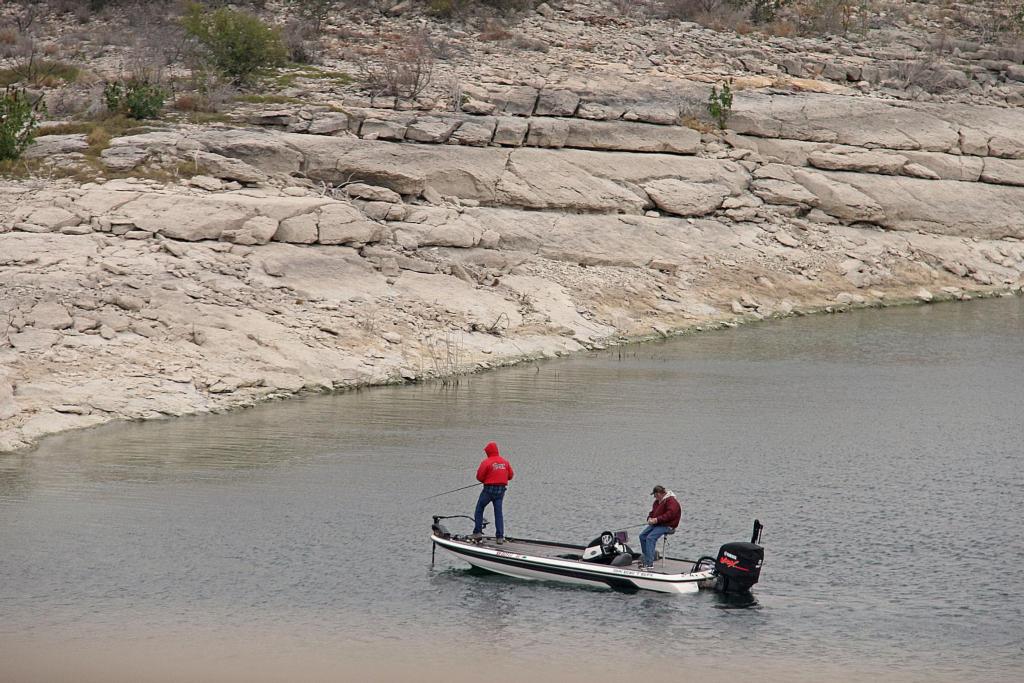
Its Spanish name means “friendship” and bass anglers who value that rare mix of quality and quantity will enjoy getting to know Lake Amistad. A largemouth powerhouse that attracts a steady stream of tournament and casual angling interest to its namesake National Recreation Area – the Rio Grande reservoir just 12 miles northwest of Del Rio, Texas – also abounds in subtle scenic beauty, historical treasures and some cross-cultural accents you won’t want to miss.
Del Rio (pop. 38,000) presents a geological and cultural oasis awash in unexpected gems right on the edge of the Chihuahuan Desert. Situated on the north shore of the Rio Grande, nearby San Felipe Springs accounts for the town’s fresh and fertile complexion – a real desert rose in this otherwise arid environment.
 The springs provide 40 percent of the Rio Grande’s flow south of Del Rio, via the confluence of the San Felipe River. Damming the Rio Grande in 1969 – a joint U.S.-Mexican project – created 64,900-acre Lake Amistad. Situated at the Rio Grande’s confluence with the Devils River along the United States/Mexico border, this clear water reservoir has a maximum depth of 217 feet with a surface elevation of 1,117 feet above mean sea level at full pool.
The springs provide 40 percent of the Rio Grande’s flow south of Del Rio, via the confluence of the San Felipe River. Damming the Rio Grande in 1969 – a joint U.S.-Mexican project – created 64,900-acre Lake Amistad. Situated at the Rio Grande’s confluence with the Devils River along the United States/Mexico border, this clear water reservoir has a maximum depth of 217 feet with a surface elevation of 1,117 feet above mean sea level at full pool.
Primary cover includes rocky points, ledges, canyon walls, bridges and a good smattering of huisache trees, mesquites and salt cedars. Amistad also sees extensive warm-season hydrilla growth, so the fish have a lot of cover no matter what the water level.
Visitors enjoy endless pleasure boating, water skiing, diving and paddle sports, but the incredible largemouth bass fishing ranks among the nation’s best. A vast area coupled with diverse habitat and great numbers of large fish equals tremendous sporting opportunities.
How to catch them
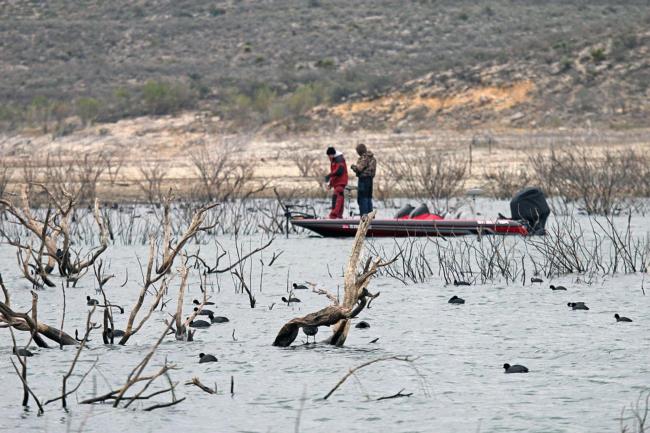 With high canyon walls comprised of parched layered rock, numerous creeks with meandering channel edges studded with skeletons of hardwoods, slow tapering points with loose rubble and flooded huisache and deep offshore structure, Lake Amistad offers abundant scenarios to fit just about any style of southern fishing. Throughout the year, first-timers fare well by targeting points, particularly those studded with huisache. Such spots are typically most productive for flipping tubes and working spinnerbaits in close, or backing out and walking football head jigs over the stair-step bottom.
With high canyon walls comprised of parched layered rock, numerous creeks with meandering channel edges studded with skeletons of hardwoods, slow tapering points with loose rubble and flooded huisache and deep offshore structure, Lake Amistad offers abundant scenarios to fit just about any style of southern fishing. Throughout the year, first-timers fare well by targeting points, particularly those studded with huisache. Such spots are typically most productive for flipping tubes and working spinnerbaits in close, or backing out and walking football head jigs over the stair-step bottom.
During the spawning season, when several groups of fish move into and out of the shallow creeks and pockets, anglers can find these waves of fish at various stages all the way out to the main lake. As Ranger pro Stephen Johnston notes, this stratified spawning movement creates such depth diversity that he has literally caught fish from 3 feet out to 50 feet on the same day.
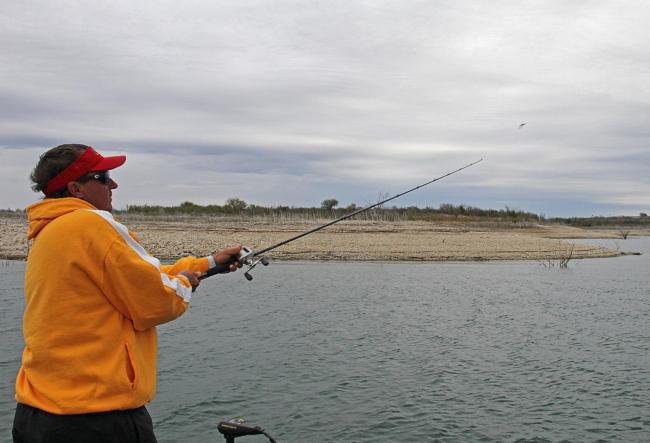 “That’s what’s so neat about this lake; you can really fish your style of fishing,” said Johnston. “If you’re a deep guy, you can fish deep; if you want to fish shallow, you can fish shallow. There’s no telling how many different ways there are to catch fish on this lake at different depths on different baits.”
“That’s what’s so neat about this lake; you can really fish your style of fishing,” said Johnston. “If you’re a deep guy, you can fish deep; if you want to fish shallow, you can fish shallow. There’s no telling how many different ways there are to catch fish on this lake at different depths on different baits.”
FLW angler and local fishing guide Ray Hanselman said that spring in Amistad is prime time for jerkbaits and crankbaits – ranging from shallow square bills to the deep stuff where a Strike King 6XD reaches. Fish that move in tight to spawn around the huisache will hit all the usual flip and pitch baits like Texas-rigged Brush Hogs, beavers, Hag’s Tornado, tubes and jigs. And, if you like slinging hefty lures, Amistad won’t disappoint.
“Some lakes, you have to use 5- to 7-inch stuff, but here you can use 7- to 12-inch stuff,” Hanselman said. “This is one of the best swimbait lakes in the nation – clear water, big fish. Your hollow body swimbaits, all the way up to your 7-inch Ospreys or Jerry Rago’s will catch fish. You can use big flukes and big Senkos, too.”
Hanselman links Amistad’s big-bait affinity with its large forage. Native gizzard shad and bluegill, along with descendants from tilapia stocked decades ago, keep lunker largemouth fat and feisty. Notably, the Lateral Perch – a sort of hybrid jig/swimbait designed by FLW competitor and Del Rio-based Power Tackle owner Tim Reneau – is a good bet for Amistad bass with big appetites.
Hanselman said post-spawn fish move to main-lake flats where anglers catch them while drifting with Carolina-rigged lizards and flukes or long-lining Texas-rigged worms or craws – all in watermelon, green pumpkin or Junebug colors. This time of year also sees good topwater action, particularly around the June bluegill spawn when Hanselman likes oversized surface baits like the Black Dog Lunker Punker and Zara Spook. When summer brings big stands of pepper grass, a hollow body frog or a buzz toad draws vicious strikes.
Fall sees the usual shad-gorging frenzy in the creeks where a mix of flukes, topwaters, spinnerbaits and lipless crankbaits will keep you busy. And when the cold weather arrives, deep-diving crankbaits, jigging spoons, football head jigs and Carolina rigs are the way to go.
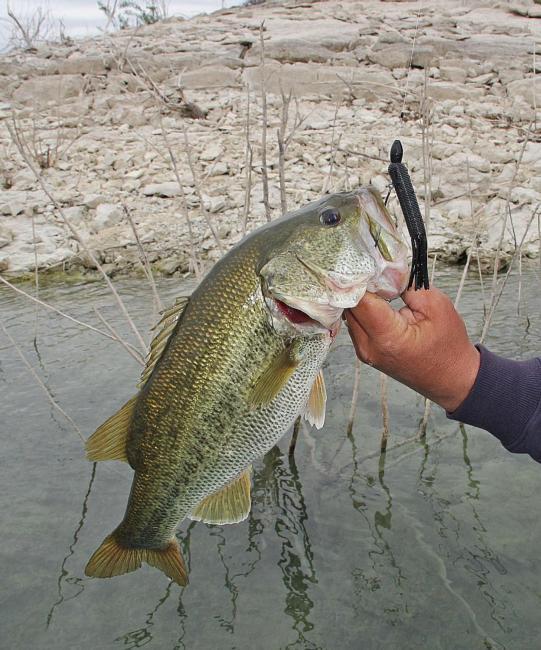 Hanselman notes that, despite Amistad’s exceptional clarity, the fish aren’t terribly line shy. In fact, the extreme visibility provides a front-row seat to bass class.
Hanselman notes that, despite Amistad’s exceptional clarity, the fish aren’t terribly line shy. In fact, the extreme visibility provides a front-row seat to bass class.
“It’s a good lake to learn to fish on,” Hanselman said. “You get to see fish and how they react to different things. You get to see how they react to people pressure, as well as barometric pressure. I’ve lived here all my life and this lake (offers good opportunities) to read bass and understand how they react and respond to different situations. By watching the bass, you’ll see what triggers them to actually feed on baitfish. A bass and a bluegill will swim side-by-side because the bass knows he can’t just shoot out and catch it. He has to wait for that bluegill or baitfish to act erratically. You have to learn how to trigger a fish out of instinct rather than hunger.”
Points of interest
Del Rio facilitates U.S.-based visits with all the conveniences of modern lodging, dining and an airport right in town. Here, you’ll find comfortable and affordably priced hotels, while several fishing lodges and campgrounds offer options closer to the water. From Del Rio, follow Highway 90 west to access one of the lake’s many convenient launch sites.
Many have become enamored with Del Rio’s modest, yet deeply-rooted charm. In fact, the area’s gritty, authentic “western” feel so captivated John Wayne that he had a movie studio built just south of town for his 1960 film, “The Alamo.” The facility now known as Alamo Village still serves the movie industry today, while also offering tours, reenactments and themed events.
Several decades after “The Duke” performed here, the Cohen brothers filmed parts of “No Country for Old Men” here and also a short hop across the Rio Grande to Ciudad Acuna, Mexico. A convenient border crossing connects U.S. visitors to a cross-cultural experience in one of Mexico’s safest and most stable border towns where the sights, sounds and culinary delights of “Old Mexico” complement this modern manufacturing center.
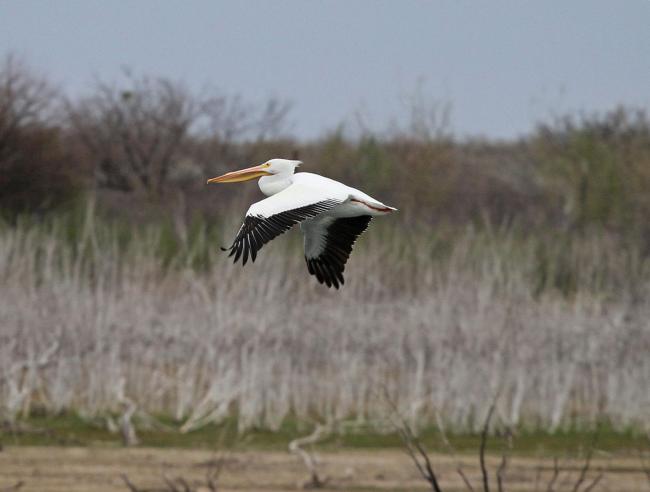 Visitors here will also find the state’s oldest winery (Val Verde Winery, 1883), bull riding competitions, amateur gunfight contests (non-lethal, of course) and thrilling air shows from nearby Laughlin AFB. If you spend a lot of time behind the telephoto lens or binoculars, you’ll appreciate Amistad’s endless wildlife viewing opportunities. Resident hawks, cara-caras and grebes see huge numbers of migratory ducks including pintails, wigeon, canvasbacks, buffleheads, shovelers, ruddy ducks, loons and white pelicans wintering in the South Texas warmth. Other critters you may spit include whitetail deer, Rio Grande turkeys, foxes, bobcats, lynx and a pig-like animal called a javalina (pronounced “hav-a-leena”).
Visitors here will also find the state’s oldest winery (Val Verde Winery, 1883), bull riding competitions, amateur gunfight contests (non-lethal, of course) and thrilling air shows from nearby Laughlin AFB. If you spend a lot of time behind the telephoto lens or binoculars, you’ll appreciate Amistad’s endless wildlife viewing opportunities. Resident hawks, cara-caras and grebes see huge numbers of migratory ducks including pintails, wigeon, canvasbacks, buffleheads, shovelers, ruddy ducks, loons and white pelicans wintering in the South Texas warmth. Other critters you may spit include whitetail deer, Rio Grande turkeys, foxes, bobcats, lynx and a pig-like animal called a javalina (pronounced “hav-a-leena”).
Ancient art
 A must-see for Amistad visitors are the Native American pictographs (cave painting) found at several sites around the lake. Parida Cave and Panther Cave are accessible from the lake, as well as on foot, while the Fate Bell Shelter – a huge cliff overhang – resides in Seminole Canyon State Park, just off of Highway 90, north of the lake. An easy 45-minute drive from Del Rio, the park features a welcome center with interpretive historical/cultural displays, examples of authentic earth ovens and markers identifying indigenous desert plants such as the fibrous sotol used by cave dwellers for primitive bedding.
A must-see for Amistad visitors are the Native American pictographs (cave painting) found at several sites around the lake. Parida Cave and Panther Cave are accessible from the lake, as well as on foot, while the Fate Bell Shelter – a huge cliff overhang – resides in Seminole Canyon State Park, just off of Highway 90, north of the lake. An easy 45-minute drive from Del Rio, the park features a welcome center with interpretive historical/cultural displays, examples of authentic earth ovens and markers identifying indigenous desert plants such as the fibrous sotol used by cave dwellers for primitive bedding.
Believed to be the work of a long lost people who adorned their cave walls and ceilings some 4,000-12,000 years ago, all of the pictographs in the Amistad area feature the Lower Pecos River style – a painting form found only within 50 miles of where the Pecos and Rio Grande rivers intersect. Using black, yellow, red, and white paints made from natural minerals mixed with deer fat and marrow and emulsified with yucca flesh, the vivid paintings range from everyday images of deer, peyote and corn to zoomorphs – mythical creatures blending the physical traits of multiple animals.
In the Fate Bell Shelter, the largest pictograph panel has been interpreted as the ancient people’s creation story in which ancestors journeyed to the underworld and brought forth the moon, stars and sun. Apparently, there were no bass boats in the underworld, as the resulting pictographs would certainly have included a big mossback airing it out over Amistad’s sparkling waters.
Local Info
For visits to Amistad, contact the Del Rio Chamber of Commerce for lodging, dining and entertainment and for information on lake access and lake use permits, visit the National Park Service website. For guidance on Amistad, contact Ray Hanselman. To find out more information on Seminole Canyon State Park, click here.